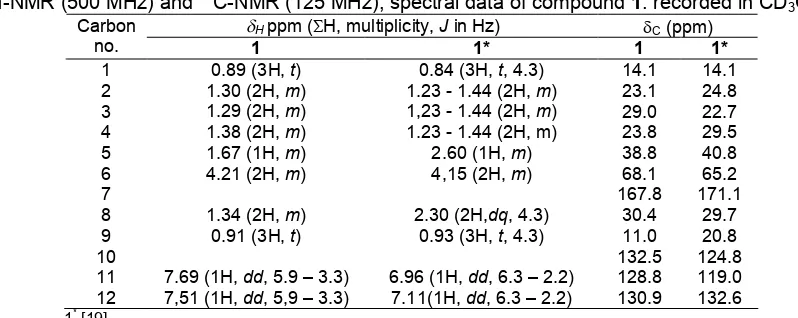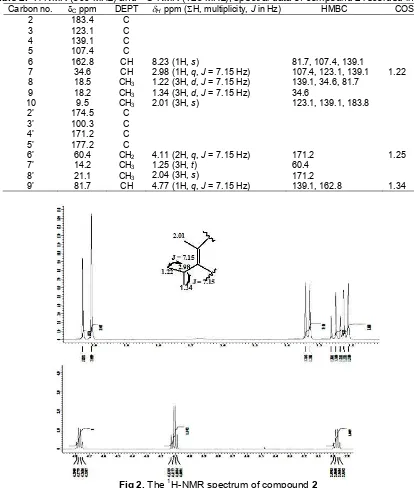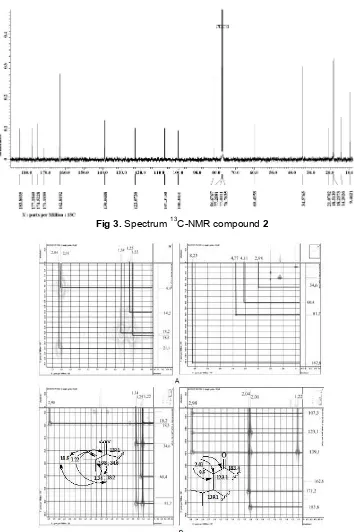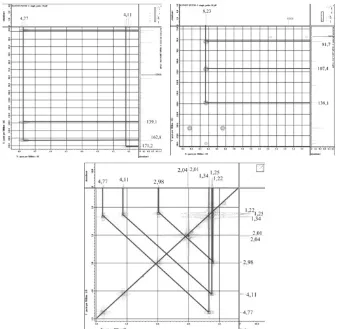Accredited by DIKTI No : 58/DIKTI/Kep/2013 Date : 22 August 2013 ISSN 1411-9420 INDONESIAN JOURNAL OF CHEMISTRY
Vol. 14, No. 3, November 2014
Editor in Chief
Prof. Dr.rer.nat. Nuryono, MS Email: nuryono_mipa@ugm.ac.id Department of Chemistry, Universitas Gadjah Mada
Sekip Utara, Yogyakarta Indonesia 55281, Tel/Fax (0062-274)-545188. Website :http://www.ijc.chemistry.ugm.ac.id
Email :ijc@ugm.ac.id or ijcugm@yahoo.com Vice Editor in Chief
Prof. Dr. Harno Dwi Pranowo, M.Si Email: harnodp@ugm.ac.id or harnopranowo@yahoo.com Prof. Dr. Mudasir, M.Eng Email: mudasir@ugm.ac.id or m_mudasir@hotmail.com
Editorial Board
Prof. Dr. Karna Wijaya, M.Eng.(Physical/Material Chemistry) Drs. Iqmal Tahir, M.Si.(Computational/Physical Chemistry) Dr. Ria Armunanto, M.Si.(Computational/Physical Chemistry) Dr. Tri Joko Raharjo, M.Si.(Biochemistry/Bioanalysis)
Dr. Nurul Hidayat Aprilita(Analytical/Environmental Chemistry)
Advisory Editorial Board
Dr. Brian Williams (Adelaide University Australia) Prof. Dr. Muhammad Idiris Saleh (University Sains Prof. Dr. Dr. Hc. Bernd M Rode (University of Malaysia)
Innsbruck, Austria) Dr. Hery Haerudin (Pertamina, Indonesia)
Dr. Dirk Bax (Utrecht University, Netherlands) Prof. Dr. Iip Izul Falah (Universitas Gadjah Mada, Prof. Dr. M. Gross (Louis Pasteur University, France) Indonesia)
Prof. Dr. Hardjono Sastrohamidjojo (Universitas Prof. Sri Juari Santosa, M.Eng, Ph.D. (Universitas
Gadjah Mada, Indonesia) Gadjah Mada, Indonesia)
Prof. Dr. David. St. C. Black (University of New South Prof. Dr. Endang Tri Wahyuni, MS (Universitas Gadjah
Wales, Australia) Mada, Indonesia)
Prof. Dr. Max Lu (University of Queensland, Australia) Prof. Dr. Bambang Rusdiarso, DEA (Universitas Gadjah Prof. Dr. Buchori (Bandung Institute of Technology, Mada, Indonesia)
Indonesia) Prof. Dr. Wega Trisunaryanti, M.S., Ph.D. Eng
Prof. Dr. Abdul Ra’uf Pathong (Hasanudin University, (Universitas Gadjah Mada, Indonesia)
Indonesia) Prof. Dr. Sabirin Matsjeh (Universitas Gadjah
Prof. Dr. Naoki Yoshioka (Keio University, Japan) Mada, Indonesia)
Assoc. Prof. Dr. Wan Ahmad Kamil Mahmood Dr. Winarto Haryadi, M.Si. (Universitas Gadjah Mada,
(University Sains Malaysia) Indonesia)
Administrator
Dr. Akhmad Syoufian Robby Noor Cahyono, S.Si., M.Sc
Warakustarti Listyariwangi, A.Md Nurzanah Hidayanti, A.Md Djoko Prihandono
Aims and Scope
Indonesian Journal of Chemistry is an international journal covering all aspects of Chemistry, including Chemical Education and Chemical Engineering. The journal publishes original research papers, short communications, and review articles, and has been indexed by SCOPUS since 2012. The paper published in this journal implies that the work described has not been, and will not be published elsewhere, except in abstract, as part of a lecture, review or academic thesis.
Accredited by DIKTI No : 58/DIKTI/Kep/2013 Date : 22 August 2013 ISSN 1411-9420 INDONESIAN JOURNAL OF CHEMISTRY
Vol. 14, No. 3, November 2014
CONTENTS
Photocatalytic Decolorization Study of Methyl Orange by TiO2-Chitosan Nanocompositesby Imelda Fajriati, Mudasir, and Endang Tri Wahyuni
209-218
Simulation of Pollutant Gas Dispersion on Case Study ofLontar 3Coal Fired Power Plant in Addition into 1 X 660 MW Capacity in Kemiri, Tangerang District, Banten Provinceby Eko Sugiharto, Taufik Abdillah Natsir, and Abdul Rozaq
219-225
Adsorption Isotherm Studies on Acid Orange-10 Dye Removal Using Cerium Dioxide Nanoparticlesby Harry Budiman and Oman Zuas
226-232
Production of Reducing Sugar from Cassava Solid Waste by Simultaneous Ultrasonication and Acid Hydrolysisby Wasinton Simanjuntak, Heri Satria, and Nurul Utami
233-238
Theoretical Analysis of Interaction Energy in Alginate-Capped Gold Nanoparticles Colloidal Systemby Foliatini, Yoki Yulizar, and Mas Ayu Elita Hafizah
239-245
Fast Swelling Superabsorbent Hydrogels Starch Based Prepared by Gamma Radiation Techniquesby Erizal, Dian Pribadi Perkasa, Basril Abbas, Sudirman, and Sulistioso G.S.
246-252
The Effect of Caramelization and Carbonization Temperatures toward Structural Properties of Mesoporous Carbon from Fructose with Zinc Borosilicate Activatorby Tutik Setianingsih, Indriana Kartini, and Yateman Arryanto
253-261
Hydrogel Based on Crosslinked Methylcellulose Prepared by Electron Beam Irradiation for Wound Dressing Applicationby Ambyah Suliwarno
262-268
Oxidation and Acetylation of Ursolic and Oleanolic Acids Isolated fromFragraea fragrans Fruits: Antiproliferation of P388 Leukemia Cellsby Dasril Basir, Julinar, Eva Agustriana, and Budi Untari
269-276
Cytotoxic Isobractatin (Prenylated Xanthone) Epimer Mixture ofGarcinia eugenifoliaby Sri Hartati, I Ketut Triyono, and Sri Handayani
277-282
Synthesis and Thermal-Stability Study of Polybutylene Itaconate Modified with Divinyl Benzene and Glycerolby Atmanto Heru Wibowo, Ninis Makhnunah, Deny Irawati, Candra Purnawan, Nanik Dwi Nurhayati, and Henning Storz
283-289
Di-(2-Ethylhexyl)Phthalate and Pyranon Derivated from Endophytic FungiPenicilliumsp the Leave of Kunyit Putih (Curcuma zedoaria)by Muharni, Fitrya, Milanti Okta Ruliza, Dwi Anjar Susanti, and Elfita
290-296
Major Anthocyanin Pigments in theFicus padanaFruits: HPLC-DAD-ESI-MS Identification and Antioxidant Activityby Daimon Syukri, Djaswir Darwis, and Adlis Santoni
297-303
Isolation of Bioactive Compounds fromAspergillus terreusLS07by Rizna Triana Dewi, Sanro Tachibana, Puspa Dewi, L.B.S. Kardono, and Muhammad Ilyas
304-310
Short Communication: Synthesis and Characterization of [Fe(Picolinate)3][MnNi(Oxalate)3].CH3 OH Polymeric Complexby Fahimah Martak, Djulia Onggo, Ismunandar, and Agung Nugroho
Accredited by DIKTI No : 58/DIKTI/Kep/2013 Date : 22 August 2013 ISSN 1411-9420 INDONESIAN JOURNAL OF CHEMISTRY
Vol. 14, No. 3, November 2014
CONTENTS (Continued)
Cover picture :
See Imelda Fajriati et al., page 212 & 215
The hypothetic interaction between TiO2 and
chitosan (above) & SEM images of chitosan bulk and TiO2-chitosan nanocomposite (NK 0.13)
Accredited by DIKTI No : 58/DIKTI/Kep/2013 Date : 22 August 2013 ISSN 1411-9420 INDONESIAN JOURNAL OF CHEMISTRY
Vol. 14, No. 3, November 2014
Organization of Manuscripts
The submitted manuscripts are classified into three categories: original paper which presents original works in detail, notes and/or short communications which present novel and/or valuable information and reviews which present a general survey of specialized subject in chemistry. All manuscripts should be written in concise and clear English and suggested to be typed with full justification, singled spaced for abstract, references, figure captions and tables (tables and figures should be typed on separate sheets at the end of the manuscript): double spaced for text, in Arial 11, using no more than 20 pages for original papers, 10 pages for notes and/or short communication and 30 pages for reviews. Left and right margins should be 3.0 cm length. The title should be typed in Arial 12 bold. The names of the authors and addresses at which the research was done, including postal code, should appear under the title. Use Arabic number typed as superscript to link authors to their addresses and asterisk to indicate the author(s) to whom correspondence should be addressed. Main headings (Abstract, Introduction, Experimental, Results and Discussion, Conclusions) are typed in bold and capital italics. Type all headings aligned left and lower case except the first letter of the first word or any proper name. The manuscripts should be written in English or in Indonesian, but the abstract must be written in English and contains no more than 200 words followed by 3-5 keywords. All references should be prepared according to the following style: Article in Journal:Barrer, R.M. and Craven, R.J.B., 2000,Phys. Chem., 2, 545–550.Chapter in a Book:Rao, C.N.R, and Rao, K.J., “Ferroics” inSolid State Chemistry Compounds. Eds. Cheetam, A.K., and Day, P, P., Clarendon Press, Oxford, 1992, 281-96.Whole Book: Barrer, R.M. and Craven, R.J.B., 1986, New Developments in Zeolite Science and Technology, ed. Murakame, Y, Iijima, A. and Ward, J.W., Kodansha, Tokyo, p.521. Text references to the literature must be numbers in square brackets. Journals titles should be abbreviated according to the Chemical Abstract Service Source Index (CASSI).
Template file of the article could be downloaded in the website:
http://www.ijc.chemistry.ugm.ac.id/author/ijctemplate.doc Acknowledgment
All other contributing individuals should be typed and acknowledged at the end of the manuscript.
Submission of Manuscripts
Please submit your article by online submission at http://pdm-mipa.ugm.ac.id/ojs/index.php/ijc/ or via email: ijcugm@yahoo.comorijc@ugm.ac.id
An IDR 800,000.00 (Java-Bali) and IDR 1,000,000.00 (outside Java-Bali) fee per article may be paid for papers published in this journal. This fee includes automatic subscription of the journal for one volume (3 issues). Subscription fee charged to overseas is USD 100 for 1 (one) copy of the journal and the article in pdf format. Articles of more than 7 pages (after layout) are subject to additional cost of IDR 75,000.00 per extra page. Color printing fee is IDR 100,000.00 per page.
Author may reproduce/republish portions of their published contribution without seeking permission from the Dept. of Chemistry, Universitas Gadjah Mada (UGM), provided that any such republication is accompanied by an acknowledgement in the form: (Original Citation-Reproduced by Permission of The Dept. of Chemistry, Universitas Gadjah Mada).
Advertising
Indo. J. Chem., 2014, 14 (3), 290 - 296
Muharni et al.
290
* Corresponding author.
Email address : muharnimyd@yahoo.co.id
DI-(2-ETHYLHEXYL)PHTHALATE AND PYRANON DERIVATED FROM ENDOPHYTIC FUNGI
Penicillium
sp THE LEAVE OF KUNYIT PUTIH (
Curcuma zedoaria
)
Muharni
1,*, Fitrya
2, Milanti Okta Ruliza
1, Dwi Anjar Susanti
1, and Elfita
1 1Department of Chemistry, Faculty of Mathematics and Natural Sciences , Sriwijaya University, Jl. Raya Palembang Prabumulih Km 32, Indralaya, Ogan Ilir, South Sumatera 30662, Indonesia
2
Department of Pharmacy, Faculty of Mathematics and Natural Sciences , Sriwijaya University, Jl. Raya Palembang Prabumulih Km 32, Indralaya, Ogan Ilir, South Sumatera 30662, Indonesia
Received October 24, 2013; Accepted July 18, 2014
ABSTRACT
Two compounds from cultivation of the endophytic fungi Penicillium sp of leaves of kunyit putih (Curcuma zedoaria have been isolated. The endophytic fungus was cultivated on 5 L of Potatos Dextrose Broth (PDB) medium at room temperature (no shaking) for 3 weeks. The cultures were extracted with ethyl acetate to afford 3.0 g of residue after removal of the solvent under reduced pressure. The extract was separated and purified by silica gel column chromatography (CC) and afforded two pure compounds as colorless oily liquid (compound1) and yellow crystal (compound 2). The structure of these compounds were characterized by detailed UV, IR, and NMR spectroscopic analysis and compound 1 as well as comparison with the reported data. Base on spectra analysis the compound 1 was determined as Di-(2-ethylhexyl)phthalate and compound 2 as 5-(4’-ethoxy-2’-hydroxy-5’-methyl-2’,3’-dihydrofuran-3’-il (hydroxy) methyl-4-isopropyl-3-methyl-2-pyran-2-on). Compound1is not new compound, but it is new for endophytic fungus from C. zeodoria and compound2is new compound.
Keywords:endophytic fungi; Penicillium sp; Curcuma zedoaria
ABSTRAK
Telah dilakukan isolasi dua senyawa dari kultifat jamur endofitik Penicillium sp dari daun kunyit putih (Curcuma zedoaria. Jamur endofit dikultur dalam 5 L medium Potatos Dextrose Broth (PDB) pada suhu kamar (keadaan statis) selama 3 minggu. Kultur kemudian diekstraksi dengan etil asetat dan dipekatkan dengan rotary evaporator sehingga didapatkan ekstrak pekat etil asetat 3,0 g. Ekstrak dipisahkan dan dimurnikan dengan kromatografi kolom menggunakan fasa diam silika gel dan didapatkan dua senyawa murni berupa cairan minyak bening (senyawa 1) dan kristal kuning (senyawa2). Struktur senyawa hasil isolasi ditentukan berdasarkan analisis data spektroskopi UV, IR, dan NMR, dan senyawa1 juga dikonfirmasi dengan membandingkan data yang telah dilaporkan. Berdasarkan analisis data spektroskopi disimpulkan senyawa 1 adalah Di-(2-ethylhexyl)phthalate dan senyawa 2 adalah 5-(4’-etoksi-2’-hidroksi-5’-metil-2’,3’-dihidrofuran-3’-il (hidroksi) metil-4-isopropil-3-metil-2-piran-2-on). Senyawa 1 bukan merupakan senyawa baru, tetapi untuk pertama kalinya ditemukan pada jamur endofitik pada C. zeodoria dan senyawa2merupakan senyawa baru.
Kata Kunci:jamur endofitik; Penicillium sp; Curcuma zedoaria
INTRODUCTION
Endophytic microorganisms that redise in the tissues of living plants and may produce secondary metabolites of biologically active [1]. Novel antibiotics, antimycotics, immunosuppressants, anticancer compound are only a few examples of what has been found after the isolation, culture and purification and characterization of some choice endophytes in the recent past. Isolation of their bioactive secondary metabolites of endophytic fungus from plant could be
selected mainly something on ethonobotanical history [2].
Indo. J. Chem., 2014, 14 (3), 290 - 296
Muharni et al.
291
In our research of endophytic fungus, many bioactive compounds and new compounds were isolated [8-9]. In this paper we reported the isolation and structural identification one known compound namely Di-(2-ethylhexyl)phthalate (1) and one new compound as 5-(4’-ethoxy-2’-hydroxy-5’-methyl-2’,3’-dihydrofuran-3’-il (hydroxy) methyl-4-isopropyl-3-methyl-2-pyran-2-on) (2) of Penicillium sp from the leaves of C. zedoaria. Penicillium species isolated as endophytic usually be found in plants zingiberaceae [10] and meliaceae family, although in marine organisms, three meroterpenes preaustinoids, A, B, A1, A2, and B1 have been reported to be isolated from Penicillium sp associated with the Melia azedarach [11]. Penicillium commune from the semi-mangrove plant Hibiscus tiliaceus, have been isolated one new compound 1-O-(2,4-dihydroxy-6-methylbenzoyl)-glycerol along with thirteen known products including 1-O-acetylglycerol, N-acetyl tryptophan, 3-indolylacetic acid methyl ester, 1-(2,4-dihydroxy-3,5-dimethylphenyl)ethanone, 2-(2,5-dihydroxy phenyl)acetid acid, (4R,5S)-5-hydroxyhexan-4-olide,
thymidine, uracil, thymine, ergosterol, β-sitosterol, β-daucosterol, and ergosta-7,22-dien-3β,5α,6β-triol [12].
EXPERIMENTAL SECTION Materials
The leaves of kunyit putih were collected on May 2013 from the Indralaya, Ogan Ilir, South Sumatra. Material for isolation endophytic fungi: ethanol 70%, NaOCl, chloramphenicol, potato dextrose broth (PDB), potato dextrose agar (PDA), silica gel 60 (70-230 mesh), thin layer chromatography (TLC) from Merck (Art.5554) silica gel 60 F254,n-hexane, ethyl acetate, and methanol.
The organic solvents were used from distilled technical grade.
Instrumentation
The apparatus in the research were counter colony, autoclave, incubator, water bath, microscope, magnetic hotplate, UV lamp, column chromatography and generally apparatus in organic and microbiology laboratory, melting point was determined using Fisher John Apparatus. UV spectra were determined with Varian Conc 100 instrument. IR spectra were determined on FTIR-Perkin Elmer-Spectrum One and NMR spectra were recorded at 500 MHz (1H) and 125 MHz (13C) on JEOL JNM ECA-500 spectrometer,
UV light at λ 254 nm and 365 nm.
Procedure
Isolation of endophytic fungus
The leaves sample was washed before it was processed and surface sterilized in 70% ethanol for 3 min and 0.5% NaOCl for 1 min and rinsed thoroughly with sterile distilled water. The segment sample placed on petri-plates containing potato dextrose agar medium (PDA) (200 g potato, 20 g dextrose, and 15 g agar in 1 L of H2O, supplemented with 100 mg/L of
chloramphenicol to suppress bacterial growth). The plates were incubated at 25 ± 2 °C until fungus growth appeared. The plant segments were observed once a day for the growth of endophytic fungus. Colony fungus showed difference characteristic furthermore to pure with the plated segments were immediately transferred into new PDA plates and then subcultured until pure cultures were obtained [13].
Identification of the endophyte
The endophytic fungal strain was identified by the morphological method. The morphological examination was performed by scrutinizing the fungal culture, the mechanism of spore production, and the characteristics of the spores. All experiments and observations were repeated at twice [14].
Cultivation of pure fungal strain
The purified fungus (a small park) was transferred under sterile conditions to the PDB medium. For chemical investigations, the fungal strains were static cultivated into 15 flasks (1 L each) containing 400 mL of PDB medium for 3 weeks at room temperature [12-14].
Extraction, isolation, purification, and structure elucidation
Indo. J. Chem., 2014, 14 (3), 290 - 296
Muharni et al.
292
Fig 1.Isolation of the compounds from ethyl acetate extract ofPenicilliumsp from the leaves ofC. zedoaria
Tablel 1.1H-NMR (500 MHz) and13C-NMR (125 MHz), spectral data of compound1. recorded in CD3OD Hppm (H, multiplicity,Jin Hz) C(ppm)
Carbon
no. 1 1* 1 1*
1 0.89 (3H,t) 0.84 (3H,t, 4.3) 14.1 14.1 2 1.30 (2H,m) 1.23 - 1.44 (2H,m) 23.1 24.8 3 1.29 (2H,m) 1,23 - 1.44 (2H,m) 29.0 22.7 4 1.38 (2H,m) 1.23 - 1.44 (2H, m) 23.8 29.5
5 1.67 (1H,m) 2.60 (1H,m) 38.8 40.8
6 4.21 (2H,m) 4,15 (2H,m) 68.1 65.2
7 167.8 171.1
8 1.34 (2H,m) 2.30 (2H,dq, 4.3) 30.4 29.7 9 0.91 (3H,t) 0.93 (3H,t, 4.3) 11.0 20.8
10 132.5 124.8
11 7.69 (1H,dd, 5.9 – 3.3) 6.96 (1H,dd, 6.3 – 2.2) 128.8 119.0 12 7,51 (1H,dd, 5,9 – 3.3) 7.11(1H,dd, 6.3 – 2.2) 130.9 132.6
1*[19]
of spectroscopic analysis including UV, IR, 1H-NMR,
13
C-NMR, DEPT, HMQC, HMBC, and COSY.
RESULT AND DISCUSSION
The fungus strain was identified as Penicillium sp. Penicillium species isolated as endophytes were obtained from several plant species such as, Melia azedarach [15-16]. Zingiberaceae family [14] meliaceae family, although in marine organisms as the semi-mangrove plant Hibiscus tiliaceus [17]. Fungus Penicillium spafter that cultivated on 5 L of PDB medium and then extracted with ethyl acetate to afford 3.0 g of residue. The extract (3.0 g) was separated by column chromatography to yield compound 1 (20 mg) and compound 2 (10 mg). The isolation of the compounds
from ethyl acetate extract of Penicillium sp from the leaves ofC. zedoariadescribed in Fig. 1.
Compound 1 was obtained as colorless oil liquid.
The UV spectra of 1 exhibited absorption at λmax nm :
206, 225, and 274. The bathochromic shift in addition of NaOH showed there is no wave length shift, it can concluded that there was no phenolic group. The IR spectrum showed the functional group such as carbonyl ester (1722 cm-1), C=C aromatic (1598–1462 cm-1), C-O (1273 cm-1), C-H aromatic (3070 cm-1), and C-H aliphatic (2927–2860 cm-1). The
1
H-NMR data (Table 1) disclosed the presence of two
protons as AB spin system at δH 7.69 (1H, dd, 5.9 &
3.3 Hz) and 7.51 (1H, dd, 5.9 & 3.3 Hz) that characteristic for aromatic proton at ortho substituted
ring. The proton signal at δH 4.21 ppm (2H, m) is
Indo. J. Chem., 2014, 14 (3), 290 - 296
Muharni et al.
293
Table 2.1H-NMR (500 MHz) and13C-NMR (125 MHz), spectral data of compound2recorded in CDCl3 Carbon no. Cppm DEPT Hppm (H, multiplicity,Jin Hz) HMBC COSY
2 183.4 C
3 123.1 C
4 139.1 C
5 107.4 C
6 162.8 CH 8.23 (1H,s) 81.7, 107.4, 139.1
7 34.6 CH 2.98 (1H,q,J= 7.15 Hz) 107.4, 123.1, 139.1 1.22 8 18.5 CH3 1.22 (3H,d,J= 7.15 Hz) 139.1, 34.6, 81.7
9 18.2 CH3 1.34 (3H,d,J= 7.15 Hz) 34.6
10 9.5 CH3 2.01 (3H,s) 123.1, 139.1, 183.8
2’ 174.5 C
3’ 100.3 C
4’ 171.2 C
5’ 177.2 C
6’ 60.4 CH2 4.11 (2H,q,J= 7.15 Hz) 171.2 1.25
7’ 14.2 CH3 1.25 (3H,t) 60.4
8’ 21.1 CH3 2.04 (3H,s) 171.2
9’ 81.7 CH 4.77 (1H,q,J= 7.15 Hz) 139.1, 162.8 1.34
Fig 2.The1H-NMR spectrum of compound2
alcohol group. Furthermore, the presence proton signal
at δH 1.67 ppm (1H, m) for proton methine, signal at
1.2–1.4 ppm for four methilene group, and signal at 0.89 and 0.91 as pair of multiplate (3H, m) for two methyl groups.
The 13C-NMR spectrum of compound 1 (Table 1), confirming the symmetry of the molecule, exhibited the expected 12 carbon resonance. DEPT spectrum showed to two quaterner, three methane, five methylene carbons, and two methyl groups. These spectroscopic data, by comparison of 1H and 13C-NMR data to those
Indo. J. Chem., 2014, 14 (3), 290 - 296
Muharni et al.
294
Fig 3.Spectrum13C-NMR compound2
Fig 4. HMQC correlation of proton at δH 1.23–8.23 ppm (A) and HMBC correlation of proton at δH1.23–2.98 ppm (B)
compound2
Compound2was obtained as a yellow crystal, mp. 171-172 °C. The Spectra UV (MeOH) of 2 exhibited
absorption at λmax nm: 213, 253, and 321. The
bathochromic shift in addition of NaOH exhibited
absorption at λmax nm: 213, 253, and 321. Base on
Spectroscopic data UV indicate this compound was no
phenolic group. The IR spectra (KBr) showed νmaxcm -1
: 3466.08 (OH), 2980.02 and 2935.66 (C-H aliphatic), 1625.99 (conjugated C=O), 1579.70; 1521.12; 1438.90 (C=C conjugation), and 1180.44 (C-O ether). 1H-NMR
(DMSO, 500 MHz) δH ppm and 13
C-NMR (DMSO,
Indo. J. Chem., 2014, 14 (3), 290 - 296
Muharni et al.
295
Fig 5.HMBC correlation of proton at 4.01–8.23 ppm and COSY correlation compound2
Fig 6.HMBC (A), and COSY (B)correlations and δ-assignment of compound 2 The1H-NMR spectrum, (Fig. 2) showed signal two
methyl doublet at δH1.22 and 1.34 ppm (3H,d, 7.15 Hz)
and signal methine quartet at δH 2.98 ppm (1H, q,
7.15 Hz) and one methine singlet at δH 8.23 (1H,s). At
spectrum also showed signal for methyl triplet at
δH 1.25 ppm (3H, t, 7.15 Hz), and two methyl singlet at
δH2.01 and 2.04 ppm, (3H,s) and one signal methylene
quartet at δH4.11 ppm (2H,q, 7.15 Hz).
The 13C-NMR (Fig. 3), DEPT 135 spectrum, and HMQC spectrum (Fig. 4) showed 17 signal consist that nine signal as C sp2 and 8 signal as C sp3. Analysis spectrum DEPT 135 showed 8 signal C quarternary at
δC100.3; 107.4; 123.1; 139.1; 171.2; 174.5; 177.2 and
183.8 ppm, 5 signal methyls carbon at δC 9.5; 14.2;
18.2; 18.5 and 21.1 ppm, 3 signal methines carbon at
Indo. J. Chem., 2014, 14 (3), 290 - 296
Muharni et al.
296
methylene carbon at δC 60.4 ppm. Signal carbon at
δC 183.4 ppm indicated these compound have C=O
carbonyl.
NMR 2D analysis for HMQC spectrum (Fig. 4)
showed the proton at δH 1.34 ppm correlation to carbon
at δH 18.2 ppm and proton at δH1.22 ppm correlation to
carbon at δC 18.5. HMBC spectrum showed correlation from proton at δH 1.22 and 1.34 ppm to carbon at
δC 34.6 and 139.1 ppm. Proton at δH 1.22 also
correlation to carbon at δC 18.2 ppm and proton at δH 1.34 ppm showed correlation with carbon at
δC 18.5. This data to indicated that proton δH 1.22 and
1.34 ppm bound to carbon fasten carbon δC 34.6 ppm. Proton at 1.25 ppm correlation to carbon at δC60.4 ppm.
Further HMBC spectrum showed correlation proton at δH
2.01 (3H,s) to carbon at δC123.1; 139.1 and 183.8 ppm,
and correlation proton at δH 2.04 ppm to carbon at
δC 171.2 ppm. Proton at δH 2.01 and 2.04 (3H, s) at
HMQC spectrum showed fastened with carbon at
δC9.5 and 21.1 ppm.
Proton at δH4.11 correlation to carbon atδC171.2, proton at δH 4.77 ppm showed correlation to carbon at
δC 139.1; 162.8 ppm, while proton at δH 8.23 ppm to
correlation to carbon at δC 81.7; 107.4 and 139.1 ppm. Analysis of 1H–1H COSY spectrum (Fig. 5) also to
indication of two proton spin system corresponding at δH
1.22 with proton at δH 2.98 ppm. And proton at δH1.25 to
correlation to proton at 4.11 ppm. HMBC and COSY
correlation and δ-assignment of compound showed Fig.
6. These spectroscopic data, therefore suggested that compound 2 is 5-(4’-ethoxy-2’-hydroxy-5’-methyl-2’,3’-dihydrofuran-3’-il (hydroxy) methyl-4-isopropyl-3-methyl-2-pyran-2-on).
Compound1is not new compound, but it is new for endophytic fungus from C. zedoaria and base on Dictionary Natural Products data base, 5-(4’-ethoxy-2’-hydroxy-5’-methyl-2’,3’-dihydrofuran-3’-il (hydroxy) methyl-4-isopropyl-3-methyl-2-pyran-2-on) (2) is new compound. Exploration of secondary metabolites research needs to be done in order to get the profile of organic compounds produced by endophytic fungus of C. zedoaria.
CONCLUSION
Two compounds have been isolated from the endophytic fungus Penicillium sp from the leaves of kunyit putih (C. zedoaria). Based on spectroscopic analysis and comparison data to those published in literature compound 1 was identified as Di-(2-ethylhexyl)phthalate and compound 2 as
5-(4’-ethoxy-2’-hydroxy-5’-methyl-2’,3’-dihydrofuran-3’-il (hydroxy) methyl-4-isopropyl-3-methyl-2-pyran-2-on).
ACKNOWLEDGEMENT
The authors are statement grateful to the Directorate General of Higher Education which research grant Fundamental 2013 was supported this research.
REFERENCES
1. Strobel, G., Daisy, B., and Castillo, U., 2005,Plant Pathol. J., 4 (2), 161–176.
2. Premjanu, N., and Jayanthy, C., 2012,Int. J. Inst. Pharm. Life Sci.,2 (1), 135–162.
3. Lakshmi, S., Padmaja, G., and Remani, P., 2011, Int. J. Med. Chem., 2011, 1–13.
4. Saikia, N., and Nath, S.C., 2003,J. Econ. Taxon. Bot., 27, 430–433.
5. Jang, M.K., Sohn, D.H., and Ryu, J-H., 2001, Planta Med., 67 (6), 550–552.
6. Wilson, B., Abraham, G., Manju, V.S., Mathew, M., Vimala, B., Sundaresan, S., and Nambisan, B., 2005,J. Ethnopharmacol., 99 (1), 147–151.
7. Bugno, A., Nicoletti, M.A., Almodóvar, A.A.B., Pereira, T.C., and Auricchio, M.T., 2007, Braz. J. Microbiol., 28, 440–445.
8. Elfita, Muharni, Munawar, Legasari, L., and Darwati, 2011,Indo. J. Chem., 11 (1), 53–58. 9. Elfita, Muharni, Munawar, and Aryani, S., 2012,
Indo. J. Chem., 12 (2), 195–200.
10. Xu, L., Zhou, J., Zhao, J., Li, X., and Wang, J., 2008,Lett. Appl. Microbiol., 46 (1), 68–72.
11. dos Santos, R.M.G., and Rodrigues-Fo, E., 2003, Z. Naturforsch., 58c, 663–669.
12. Yan, H-J., Gao, S-S., Li, C-S., Li, X-M., and Wang, B-G., 2010,Molecules, 15 (5), 3270–3275.
13. Barik, B.P., Tayung, K., Jagadev, P.N., and Dutta, S.K., 2010,Eur. J. Biol. Sci., 2 (1), 8–16.
14. Guo, L., Wu, J-Z., Han, T., Cao, T., Rahman, K., and Qin, L-P., 2008,Molecules,13 (9), 2114–2125. 15. Habib, M.R., and Karim, M.R., 2009, Micobiology,
37 (1), 31–36.
16. Mavar-Manga, H., Haddad, M., Pieters, L., Baccelli, C., Penge, A., and Quetin-Leclercq, J., 2008, J. Ethnopharmacol., 115 (1), 25–29.



